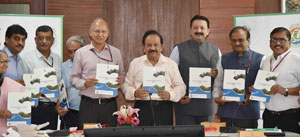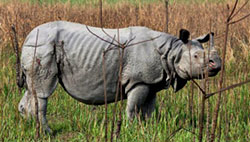August 2018 Environment
Sakshi Education
- Environment Minister Releases India’s National Redd+ Strategy
 Reiterating India’s commitment to Paris Agreement on Climate Change, Union Minister for Environment, Forest and Climate Change, Dr. Harsh Vardhan released of ‘National REDD+ Strategy India’
Reiterating India’s commitment to Paris Agreement on Climate Change, Union Minister for Environment, Forest and Climate Change, Dr. Harsh Vardhan released of ‘National REDD+ Strategy India’
What is India’s National REDD+ Strategy India?- REDD+ activities will help in sustainable livelihood of local communities and also in conservation of biodiversity.
- REDD+ strategy will help the country to fulfill its NDC commitments and will also contribute to the livelihood of the forest dependent population.
- REDD+ actions at the State level will be coordinated by the committee headed by the Principal Chief Conservator of Forests (PCCF) & Head of Forest Force (HOFF) of the States.
- In simple terms, REDD+ means “Reducing Emissions from Deforestation and forest Degradation”, conservation of forest carbon stocks, sustainable management of forests, and enhancement of forest carbon stocks in developing countries.
Aim:- REDD+ aims to achieve climate change mitigation by incentivizing forest conservation.
- The strategy seeks to address drivers of deforestation and forest degradation and also developing a roadmap for enhancement of forest carbon stocks and achieving sustainable management of forests through REDD+ actions.
Background: Paris agreement on climate change also recognizes role of forests in climate change mitigation and calls upon country Parties to take action to implement and support REDD+.
India has communicated in its Nationally Determined Contribution under Paris Agreement, that it will capture 2.5 to 3 billion tonnes of Carbon dioxide through additional forest and tree cover by 2030.
- France’s ban on bee-killing pesticides begins Saturday (01st Sep, 2018)
A ban on five neonicotinoid pesticides enters into force in France on September 1, placing the country at the forefront of a campaign against chemicals blamed for decimating critical populations of crop-pollinating bees.
With its ban, France has gone further than the European Union, which voted to outlaw the use of three neonicotinoids — clothianidin, imidacloprid and thiamethoxam — in crop fields.
Heavily agriculture-reliant France banned these three neonicotinoids plus thiacloprid and acetamiprid, not only outdoors but in greenhouses too. These are the only five neonicotinoid pesticides hitherto authorized for use in Europe.
- European Union to ban halogen bulbs from September 1
 The European Union is all set to ban the use of halogen light bulbs and households are expected to switch to LED lights.
The European Union is all set to ban the use of halogen light bulbs and households are expected to switch to LED lights.
The ban is a part of the final stage of the European Union energy rules, directive (EC 244/2009) that has banned less efficient light sources, with the aim of improving energy efficiency and cutting the carbon footprint across the EU. The union had earlier banned the traditional incandescent light bulbs in 2009.
The LED lights that will replace the bulbs are said to consume five times less energy than halogen ones.
- World Elephant Day
 World Elephant Day is an international annual event on August 12.
World Elephant Day is an international annual event on August 12.
The objective behind celebrating the World Elephant Day every year is to focus attention of various stakeholders to support various conservation policies to help elephants, including improving enforcement policies to prevent the illegal poaching and trade of ivory, conserving elephant habitats, providing better treatment for captive elephants and reintroducing some captive elephants into sanctuaries.
Facts
- As per 2017 census, Asian elephants in the country are about 30,000.
- Asian elephants are confined to South Asia and South East Asia and about 60 per cent of global population of Asian elephants is found in India.
Project Elephant
It was started in 1992, with the objectives of- conservation and protection of viable population of wild elephants in their natural habitats in the country;
- restoration of natural habitats and traditional corridors/migratory routes or movement paths used by the elephants, wherever necessary, through eco-restoration, acquisition etc;
- ensuring safeguards against poaching and other threats;
- mitigation and control of human elephant conflicts;
- welfare and management of captive elephants; and
- Creating a viable mechanism to ensure inter-state and regional and national level coordination in protecting and conserving the elephant and its ranges.
- Cows kill leopard in Maharashtra
Cows attacked a leopard for killing their calf, died on 13th August, 2018.This incident happened in Gautala wildlife sanctuary in Aurangabad.
Gautala wildlife sanctuary
- Gautala Autramghat Sanctuary is a protected area of Maharashtra state, India.
- It lies in the Satmala and Ajantha hill ranges of the Western Ghats, and administratively is in Aurangabad District and Jalgaon District.
- The wildlife sanctuary was established in 1986 in an existing reserved forest area.
- New species of orchid found in Peruvian jungle
Botanists have discovered a new species of orchid in Peru’s central Amazonian rainforest.
The new species of orchid was recently discovered in the Tingo Maria National Park.
The orchid was given the name Andiniatingomariana and has been classified as belonging to the Andinia genus.
Orchidaceae
- The Orchidaceae are a diverse and widespread family of flowering plants, with blooms that are often colourful and fragrant, commonly known as the orchid family.
- The family encompasses about 6–11% of all seed plants.
- Orchidaceae are cosmopolitan, occurring in almost every habitat apart from glaciers.
- The world’s richest diversity of orchid genera and species is found in the tropics, but they are also found above the Arctic Circle.
- Orchids have been used in traditional medicine in an effort to treat many diseases and ailments.
- Kaziranga National Park in Assam not under the ‘Adopt a Heritage’ scheme
 No sites have been adopted by any private institute in Assam under the ‘Adopt a Heritage’ scheme.
No sites have been adopted by any private institute in Assam under the ‘Adopt a Heritage’ scheme.
Any monument/heritage site/natural site for whose inclusion, the concerned asset owner (ASI, State Government etc) agrees can be considered under the Adopt a Heritage Scheme.
- Adopt a Heritage – Salient Feature of Project Guidelines
‘Adopt a Heritage’ project focusses on providing basic public conveniences and amenities which include cleanliness, drinking water, ease of access for differently abled and senior citizens, standardized signage, illumination and advanced amenities such as surveillance system, night viewing facilities, tourism facilitation centre etc.
Aim:
To involve public sector companies, private sector companies and corporate citizens/individuals to take up the responsibility for making our heritage and tourism more sustainable through development, operation and maintenance of world-class tourist infrastructure and amenities at ASI/State heritage sites and other important tourist sites in India.
Primary objectives of the project include:
To develop basic and advanced tourism infrastructure in and around heritage monuments and any other tourist sites in collaboration with the public/private sector.
To promote cultural and heritage value of the country to generate livelihoods of local communities of respective heritage site/monument/tourist site.
To develop sustainable tourism infrastructure and ensuring proper Operations and Maintenance therein and thus increase the attractiveness of the tourist destinations.
- Khangchendzonga Biosphere to be included in the World Network of Biosphere Reserves
The Khangchendzonga Biosphere Reserve has become the 11th Biosphere Reserve from India that has been included in the UNESCO designated World Network of Biosphere Reserves (WNBR).
The decision to include Khangchendzonga Biosphere Reserve in WNBR was taken at the 30th Session of International Coordinating Council (ICC) of Man and Biosphere (MAB) Programme of UNESCO held at Palembang, Indonesia, from July 23-27, 2018.
India has 18 Biosphere Reserves and with the inclusion of Khangchendzonga, the number of internationally designated WNBR has become 11, with 7 Biosphere Reserves being domestic Biosphere Reserves.
- Environmental Performance Index (Epi)
The 2018 Environmental Performance Index (Epi) ranks 180 countries on 24 performance indicators across 10 issue categories covering environmental health (50%) and ecosystem vitality (50%). The categories are
Air Quality
Water & Sanitation
Heavy Metals
Biodiversity & Habitat
Forests
Fisheries
Climate & Energy
Air Pollution
Water Resources and
Agriculture
EPI is produced by Yale Center for Environment Law and Policy, Yale University and Columbia Universities along with the World Economic Forum.
China and India rank 120th and 177th respectively, reflecting the strain rapid economic growth imposes on the environment.
Switzerland leads with a score of 87.4
France (83.95), Denmark (81.60), Malta (80.9), and Sweden (80.51) round out the top five countries in the 2018 EPI.
- PARIVESH” – an environmental single window hub for Environment, Forest, Wildlife and CRZ clearances launched
The Prime Minister, Shri Narendra Modi, launched PARIVESH (Pro-Active and Responsive facilitation by Interactive, Virtuous and Environmental Single-window Hub) on the occasion of World Biofuel Day.
PARIVESH is a Single-Window Integrated Environmental Management System, developed in pursuance of the spirit of ‘Digital India’ initiated by the Prime Minister and capturing the essence of Minimum Government and Maximum Governance.
PARIVESH, MoEFCC has become more of a facilitator, than a regulator.
“PARIVESH” is a workflow based application, based on the concept of web architecture.
It has been rolled out for online submission, monitoring and management of proposals submitted by Project Proponents to the Ministry of Environment, Forest and Climate Change (MOEFCC), as well as to the State Level Environmental Impact Assessment Authorities (SEIAA), to seek various types of clearances (e.g. Environment, Forest, Wildlife and Coastal Regulation Zone Clearances) from Central, State and district-level authorities.
It includes - single registration and single sign-in for all types of clearances (i.e. Environment, Forest, Wildlife and CRZ), unique-ID for all types of clearances required for a particular project and a single Window interface for the proponent to submit applications for getting all types of clearances (i.e. Environment, Forests, Wildlife and CRZ clearances).
- Status of National Animal
The parliament in its monsoon session discussed about the status of National Animal. It is known fact that our National animal is Tiger
Details:
237 tigers died in the country in last two years
In 2016, 122 tigers died across the country while 115 died in 2017
During 2012-17, 55% of the tiger deaths were due to natural causes while 7% were due to unnatural causes not attributable to poaching.
23% (of tigers) died due to poaching while 15% have been tiger body part or derivative seizures.
The government through Project Tiger and National Tiger Conservation Authority, has taken a number of initiatives towards anti-poaching operations.
These include creation of Special Tiger Protection Force (STPF), formulation of Security Plan guidelines which form part of the overarching Tiger Conservation Plan (TCP), development of a security audit framework and creation of an online wildlife crime database.
However unnatural deaths have not had an impact on tiger numbers which are growing at the rate of 5.8% per annum.
National Tiger Conservation Authority has a collaborative project with the Wildlife Institute of India to customize drones for various tasks including surveillance in 13 tiger landscapes.
- International Tiger Day 2018: successes and the challenges
 July 29 is celebrated as the Global Tiger Day to raise awareness about the endangered big cats. It was created when 13 countries came together in 2009 and pledged to double the world’s Tiger population by 2022 -- the next "Year of the Tiger" on the Asian lunar calendar.
July 29 is celebrated as the Global Tiger Day to raise awareness about the endangered big cats. It was created when 13 countries came together in 2009 and pledged to double the world’s Tiger population by 2022 -- the next "Year of the Tiger" on the Asian lunar calendar.
As per the assessment of the Status of Tigers, Co-predators and Prey (2014), the number of tigers in India is estimated at 2,226 as compared to the 2010 estimate of 1,706.
Poaching, prey depletion and loss of habitat continue to be major threats to their survival.
- Indian-origin mathematician wins Fields Medal
Every four years, at an international gathering of mathematicians, the subject’s youngest and brightest are honored with the Fields Medal, often described as the Nobel Prize of mathematics.
Among this year’s recipients, announced at the International Congress of Mathematicians in Rio de Janeiro, is Indian-origin AkshayVenkatesh, 36, of the Institute for Advanced Study in Princeton.
Venkatesh’s research covers a wide range of mathematical disciplines
Recently, Mr. Venkatesh and Brian Lawrence, one of Mr. Venkatesh’s former graduate students, found a different way to prove a ground-breaking theorem from the 1980s that stated that one could tell whether a set of equations had a finite number of solutions or infinitely many just by looking at the form of the equations. Although the result is not new, their novel approach could lead to further progress in understanding the solvability of equations.
Published date : 14 Aug 2018 03:04PM


















